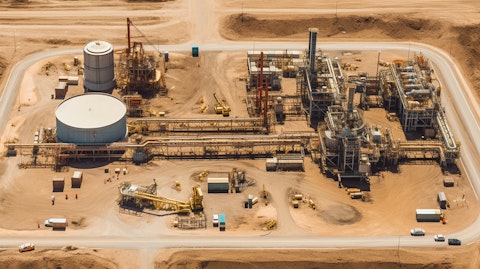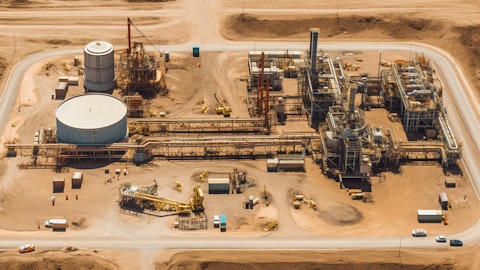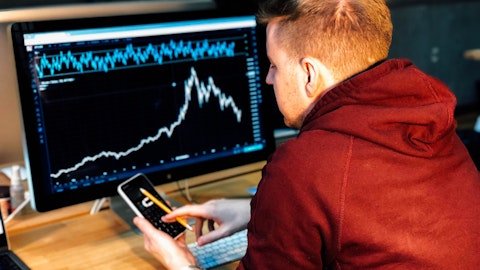Schlumberger Limited (NYSE:SLB) Q1 2024 Earnings Call Transcript April 19, 2024
Schlumberger Limited beats earnings expectations. Reported EPS is $0.75, expectations were $0.74. SLB isn’t one of the 30 most popular stocks among hedge funds at the end of the third quarter (see the details here).
Operator: Thank you, everyone, for standing by. Welcome to the SLB First Quarter Earnings Conference Call. At this time, all participants are in a listen-only mode. [Operator Instructions] As a reminder, this conference is being recorded. I would now like to turn the conference over to James R. McDonald, Senior Vice President of Investor Relations & Industry Affairs. Please go ahead.
James McDonald: Thank you, Leah. Good morning, and welcome to the SLB first quarter 2024 earnings conference call. Today’s call is being hosted from Kuala Lumpur, following our Board meeting held earlier this week. Joining us on the call are Olivier Le Peuch, Chief Executive Officer; and Stephane Biguet, Chief Financial Officer. Before we begin, I would like to remind all participants that some of the statements we will be making today are forward-looking. These matters involve risks and uncertainties that could cause our results to differ materially from those projected in these statements. I therefore refer you to our latest 10-K filing and other SEC filings which can be found on our website. We are under no obligation, and expressly disclaim any obligation to update, alter or otherwise revise any forward-looking statements, whether as a result of new information, future events or otherwise, except as required by law.
Our comments today may also include non-GAAP financial measures. Additional details and reconciliation to the most directly comparable GAAP financial measures can be found in our first quarter press release, which is on our website. And finally, SLB and ChampionX will file materials related to the proposed transaction with the U.S. Securities and Exchange Commission, including a registration statement that will contain a proxy statement/prospectus of the parties. Investors and security holders are urged to read those materials once they are available, which can be obtained from the SEC’s website and from the companies’ websites. SLB, ChampionX, their directors, executive officers, and certain members of management and their employees may be considered participants in the solicitation of proxies from their shareholders in connection with the proposed transaction.
This will be described further in the proxy statement/prospectus perspective when it is filed. With that, I will turn the call over to Olivier.
Olivier Le Peuch: Thank you, James. Ladies and gentlemen, thank you for joining us on the call today. During my prepared remarks, I will discuss three topics. I will begin by sharing an overview of our first quarter results; then, I will provide an update on the ongoing market dynamics and highlight areas where we anticipate opportunities for further growth; and finally, I will conclude with our outlook for the full year and the second quarter. Stephane will then provide more details on our financial results, and we will open the line for your questions. Let’s begin. I’m very pleased with our strong start to 2024. Year-on-year, revenue grew 13% and EBITDA grew in the mid-teens, in line with our full year financial ambitions.
Additionally, we demonstrated the differentiated value we deliver to our customers, the impact of our continued capital discipline, and execution efficiency, by expanding year-on-year adjusted EBITDA margins for the 13th consecutive quarter. Internationally, we harnessed broad-based activity growth, with 21 of our 25 international GeoUnits increasing revenue year-on-year. Even when excluding the Aker contribution, our international revenue grew by double-digits. These impressive results were led by the Middle East & Asia, which exhibited remarkable growth of 29% compared to the same period a year ago. Specifically in the Middle East and North Africa, year-on-year growth was supported by continued investments in long-cycle developments and capacity expansion projects, in both oil and gas, across Algeria, Egypt, Iraq, Libya, Qatar, Saudi Arabia, and the United Arab Emirates.
And in Asia, we saw strong activity across the region led by offshore, notably in China, Indonesia, Malaysia, the Philippines, and India. Meanwhile, in North America, activity remains soft due to weaker gas prices, sustained capital discipline, and the effects of ongoing market consolidation. The slower activity contributed to revenue in the region declining by 6% year-on-year. Next, I will comment on the Divisions’ performance. I was very proud to see the power of the core divisions continue to drive our performance this quarter. In particular, you may have seen the remarkable growth in Production Systems, supported by our OneSubsea joint venture, and in Reservoir Performance, led by increased stimulation, evaluation, and intervention services.
Well Construction also delivered resilient growth. I was also pleased to see our core margins visibly expand year-on-year, and I trust that this will continue as we remain focused on efficiency and value creation for our customers. Turning to Digital & Integration. I continue to follow our performance very closely. Although we experienced the typical pattern of seasonally slower sales to start the year, digital still grew in the double-digits year-on-year during the first quarter and we expect a visible uptick of digital sales throughout the rest of the year. This will be supported by increased customer adoption and a baseload of ongoing projects, as you can see from the quarterly highlights included in our press release this morning. For the full year, we maintain our ambition to grow our digital revenue in the high-teens.
Overall, I am very pleased with this strong start to 2024. We will remain focused on the quality of our revenue, capital discipline, and execution efficiency to generate strong cash flows and shareholder returns throughout the year. I want to thank the entire SLB team for delivering this first quarter performance. They continue to operate at a benchmark level for the industry, and I feel privileged to work with such a dedicated and talented team. Next, let me shift into the ongoing market dynamics and how these are creating opportunities for our business. We are in the midst of a unique oil and gas cycle, characterized by strong market fundamentals, growing demand, and an even deeper focus on energy security. As described on several occasions, this cycle continue to display breadth, resilience, and longevity, this is very much the case in the Asia region where we are hosting this call today.
In this context, there are certain priorities that are increasingly critical to our customers: project life-cycle reduction, particularly in exploration & appraisal to accelerate time to first gas or first oil; capital efficiency in the development phase to set new benchmarks in every basin; step change in production and recovery for producing assets and for unconventional resources; and finally, adoption of Digital & Al capabilities to transform operations and use of technology to abate emissions. Against this backdrop, we continue to innovate with our customers, through the combination of integration, fit-for-basin technologies, and digital, focusing on unlocking value by delivering lower-cost and lower-carbon barrels. In our Core oil and gas business, we are benefiting from these trends with our exposure to the fastest growing and most resilient markets.
This cycle continues to be defined by broad growth across the international basins, and there is nowhere this is more evident than in the Middle East and global offshore markets. In the Middle East, countries are investing to increase both oil and gas supplies through the end of the decade. The long-cycle nature of the investments provides further confidence in the durability of the cycle, and we look forward to continue working with our customers to deliver on these targets. And offshore, many of the FIDs from the past few years have commenced, leading to broad-based activity across Asia, Africa, Latin America, and Europe. SLB has a strong foothold in each of these offshore regions, benefiting from our deep customer relationships, operational performance, and fit-for-basin solutions.
Through our OneSubsea joint venture, we offer an unmatched pore-to-process offering throughout the full lifecycle of offshore assets, and we continue to deliver on our substantial offshore backlog. Now, looking at the priorities for producing assets today and tomorrow, we recognize the need to increase our exposure to the Production and Recovery market, including the more resilient OpEx spend, as operators work to offset natural decline, extend performance, and maximize the value of their assets. Our acquisition of ChampionX will further evolve our portfolio to capture this opportunity with the addition of a leading production chemicals business and well-established artificial lift (ph) portfolio with significant benefits to our customers in every producing basin in the world.

This will be particularly visible in the offshore environment, which requires a higher intensity of production chemicals for flow assurance, reinforcing the long-cycle value of our offshore strategy. Another notable trend in the market is the enhanced focus on emissions reduction and low-carbon energy. Our early investments in this space are beginning to deliver promising results, both in the Core through our Transition Technologies, and in our New Energy portfolio, notably in Carbon Capture and Sequestration. CCS is one of the fastest-growing and most-immediate opportunities to reduce carbon emissions, and we are leveraging our domain expertise and deep knowledge of the subsurface to respond to an increased demand in our storage solutions.
At the same time, we are also expanding to address opportunities throughout the CCS value chain. As you saw in our announcement a few weeks ago, we have entered into an agreement to combine our carbon capture business with Aker Carbon Capture and will own 80% of the combined entity. This is an exciting opportunity to bring together our complementary technology portfolios, leading process design expertise, and an established project delivery platform to innovate and deliver carbon capture technology solutions at an industrial scale. Looking across our broad portfolio, it is clear that our three engines of growth, each with differentiated technologies and exciting project pipelines, are positioning us for continued performance across all time horizons.
Supported by our strong international portfolio and our unique technology driven approach to North America, we are truly making this investment cycle better for longer. Finally, I will conclude with our outlook for the full year and the second quarter. Based on the commentary I have just shared, the ongoing characteristics of the cycle, and our strong first quarter results, we remain confident in our full year financial guidance, with strength in international activity offsetting slower growth in North America. In particular, we anticipate the activity momentum in the international markets to continue, driven by increasing global demand and an even deeper focus on energy security. The relevance of oil and gas in the energy mix continues to support further investments in capacity expansion, particularly in the Middle East and in long-cycle projects across the global offshore markets, fully aligned with our international revenue ambitions.
Additionally, we expect to realize further growth in the strengthening production and recovery market as operators work to maximize the efficiency and longevity of their producing assets. Altogether, this continues to present a very strong outlook for our business during 2024 and beyond. Specific to the second quarter, we expect sequential revenue growth internationally in the mid-single digits and North America in the low-single digits. We also expect to expand adjusted EBITDA margins by 75 bps to100 bps. By Division, we expect sequential growth to be led by Digital & Integration, followed by Reservoir Performance, Production Systems, and Well Construction, all of which are rebounding from the conclusion of winter seasonality. I will now turn the call over to Stephane.
Stephane Biguet: Thank you, Olivier. Good morning, ladies, and gentlemen. First quarter earnings per share excluding charges and credits was $0.75. This represents an increase of $0.12 when compared to the first quarter of last year. In addition, during the first quarter, we recorded $0.01 of merger and integration charges associated with our 2023 acquisition of the Aker subsea business. Overall, our first quarter revenue of $8.7 billion increased 12.6% year-on-year. Excluding the impact of the Aker subsea acquisition, revenue increased 6.5% when compared to the same quarter last year. International revenue was up 18% year-on-year, and more than 10% when excluding the contribution from Aker, driven in particular by year-on-year growth of 29% in the Middle East & Asia.
North America revenue decreased 6% year-on-year, primarily due to lower rig count in U.S. land and the effect of lower gas pricing which impacted our APS project in Canada. Company-wide adjusted EBITDA margin for the first quarter was 23.6%, up 51 basis points year-on-year. In absolute dollars, adjusted EBITDA increased 15% year-on-year. This is in line with our guidance for adjusted EBITDA to grow in the mid-teens for the full year of 2024. Our pre-tax segment operating margin increased 95 basis points driven by strong incremental margins internationally. Let me now go through the first quarter results for each division. First quarter Digital & Integration revenue of $953 million increased 7% year-on-year as Digital revenue experienced double-digit growth while APS revenue was flat.
Margins declined 300 basis points year-on-year to 26.6% due to the effects of higher APS amortization expense and lower commodity prices on our APS project in Canada. Margins for the Digital & Integration Division are expected to improve in Q2 and throughout the rest of the year, as digital sales will increase sequentially, in line with the usual seasonal trend. Reservoir Performance revenue of $1.7 billion increased 15% year-on-year due to strong stimulation activity, particularly in Middle East & Asia and offshore. Margins expanded 356 basis points as compared to the first quarter of last year to 19.7% driven by higher activity and improved pricing. Well Construction revenue of $3.4 billion increased 3% year-on-year as International growth of 9% was largely offset by lower revenue in North America.
Margins of 20.5% were essentially flat year-on-year. Finally, Production Systems revenue of $2.8 billion increased 28% year-on-year. Excluding the effects of the acquired Aker subsea business, Production Systems revenue grew 6% driven by strong international sales. Margins of 14.2% expanded 490 basis points year-on-year driven by a favorable activity mix, strong execution, and pricing improvements. Now turning to our liquidity. During the quarter, we generated $327 million of cash flow from operations. Free cash flow of negative $222 million was slightly better than the same period last year. These cash flows reflect the seasonal effects of the payout of our annual employee incentives and lower cash collections following very strong receivable performance in the fourth quarter of last year.
Consistent with our historical trend, free cash flow is expected to be higher in the second quarter and to continue to increase in the third and fourth quarters. Capital investments, inclusive of CapEx and investments in APS projects and exploration data were $549 million in the first quarter. For the full year, we are still expecting capital investments to be approximately $2.6 billion. During the quarter, we repurchased 5.4 million shares for a total purchase price of $270 million. As we disclosed a couple of weeks ago, we have raised our 2024 target for total returns of capital to shareholders from $2.5 billion to $3 billion. This $3 billion will be evenly split between dividends and share repurchases. Lastly, we plan on filing our S-4 registration statement relating to the ChampionX acquisition in the next couple of weeks.
The transaction will require the approval of ChampionX shareholders. During the period after ChampionX mails its proxy for the merger until its shareholder vote, we are required to suspend our share buyback program. While this will not impact our total share repurchases for the year of approximately $1.5 billion, it will potentially result in our buybacks being more heavily weighted towards the second half of the year. I will now turn the conference call back to Olivier.
Olivier Le Peuch: Thank you, Stephane. Ladies and gentlemen, I believe, we are opening the floor for your questions.
Operator: [Operator Instructions] And our first question comes from James West with Evercore ISI. Please go ahead.
See also ChatGPT Stock Predictions: 10 Stocks That Have 10X Potential and 30 Countries with the Highest Vulnerable Employment in the World.
Q&A Session
Follow Schlumberger Limited (NYSE:SLB)
Follow Schlumberger Limited (NYSE:SLB)
James West: Hey. Good morning, Olivier and Stephane.
Olivier Le Peuch: Good morning
Stephane Biguet: Good morning.
James West: So Olivier, I know you alluded to it earlier, and you and I have had conversations about the cycle recently as well. But how are you thinking about in the last six, eight weeks or so as we’ve seen just increased amounts of contracts and rig awards, and subsea equipment awards. How are you thinking about where we are in this cycle today and the duration of the cycle? Because it seems to me, we’re — right now, it’s a Middle East, Asia and offshore story, but certainly going to broaden out to more regions as well. So I’m curious to kind of get your big picture high-level thoughts.
Olivier Le Peuch: Thank you, James. So from our perspective, I think, first and foremost, I think the cycle attributes that we have described earlier, the breadth, the resilience, the durability or the longevity of the cycle are fully in place and are driven by a combination of strong fundamental energy demand, oil and gas demand, if anything is trending upwards from the revision. Energy security is still on top of the agenda. There is no other place than Asia to realize this on the ground. And as such, I think the base of (ph) activity is being supported by very critical flow of investment, both as you said, in capacity expansion, which is already committed. But also, I think in short-cycle and long-cycle offshore, deepwater and shallow.
And I think I was here in Asia, and it was remarkable to see the breadth, the diversity of the opportunity, the number of countries, offshore, onshore, the new exploration appraisal cycle, the new entrants that are coming in Southeast Asia, they were not before to invest because they are looking for securing gas supply, and they are looking to participate to maintain oil production. So I believe that if you combine this with what is happening in North America, which is North America operating within a threshold and not necessarily with significant anticipation of supply growth in that market in short term. This is only accentuating the characteristics of the cycle in international. And it can — if I can reflect from the last two or three months of a lot of customer engagements, the sentiment is trending more positively than it was maybe six or 12 months ago.
Hence, customer engaging to secure capacity on long projects such as deepwater and subsea, and they are looking for partnership collaboration to make sure that we help them into securing the best capital efficiency, as I highlighted, look for integration to accelerate the product cycle to get faster to first oil, first gas. So if anything, I think I see more, stronger pipeline of projects that will help us — help this cycle to prolong beyond what we could have anticipated a year ago.
James West: Right. Got it. Okay. Makes a lot of sense. And then maybe just as a follow-up on the digital side and the rollout of the Delfi platform. How do you feel about the progress that’s happening there, the adoption by customers? I know you’ve got a good number of customers so far, but still the penetration is probably not nearly where it will be in three to five years, but it’s a powerful tool and so how do you see adoption trending from here?
Olivier Le Peuch: I think the adoption continues to trend favorably. I think you’ll continue to see as we deliver quarter-after-quarter both sorts of announcements in digital operation in cloud adoption for geoscience workflow or in data and AI, as you have seen the diversity of what we announced this quarter. I do expect the same next quarter and the following quarter because we believe that customers are realizing that they need to unlock efficiency and they need to accelerate the cycle, and they need to extract lower carbon solutions for their assets. So this is pulling. So we are still — and we have renewed our ambition and targets to reach or exceed high teens for digital growth this year. And we started the year, I would say, considering the seasonal low – in the teens — low teens growth year-on-year, double-digits, that was fully aligned with what we could have anticipated and it will continue.
So I see quarter-after-quarter expansion of digital adoption. And I see more and more contribution from digital operations, be it drilling automation with production operation solutions, and you will see that in the coming quarter and the upcoming transaction with ChampionX will only strengthen this production operation offering as it will complement and give us another platform to expand our digital adoption. So I remain very constructive, and I believe that it is a long trend of digital adoption that will continue throughout the rest of the decade.
James West: Got it. Perfect. Thanks, Olivier.
Olivier Le Peuch: Thank you, James.
Operator: Next, we move on to David Anderson with Barclays. Please go ahead.
David Anderson: Thank you. Good morning, Olivier and Stephane.
Olivier Le Peuch: Good morning, David.
Stephane Biguet: Good morning.
David Anderson: So just a question on kind of the timing of the ChampionX deal and sort of, as it relates to where we are in the cycle. So these are all product lines that are targeting the production side of the well life cycle, primary drivers can be OpEx spending, particularly with deepwater development ramping up in the coming years. Conversely, the timing of acquiring a later cycle company might suggest that you’re positioned for upstream spending to be structurally slow in the coming years. So could you just help us understand a little bit the dynamics as sort of the OpEx cycle and the CapEx cycle? I totally appreciate the duration of it, but I guess I’m sort of thinking about the sort of the cadence of the different cycles. Can you just help us understand kind of how the timing of that works out and maybe you just see the OpEx cycle expanding higher, but the two dynamics, I think, are causing a little bit of questioning in the market, I guess, today.





